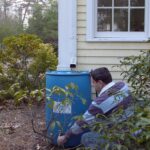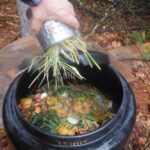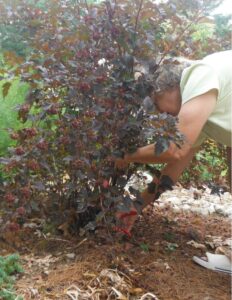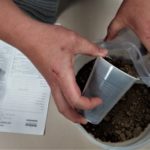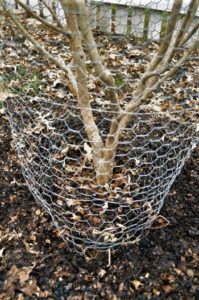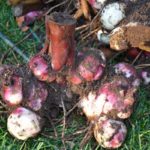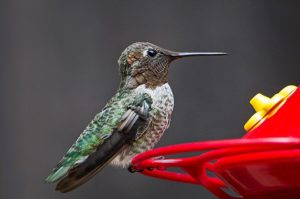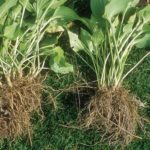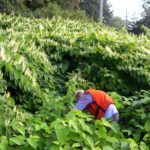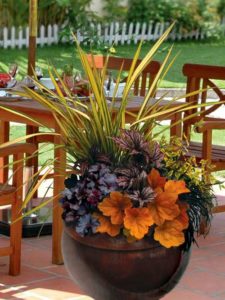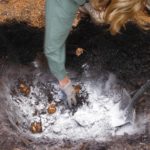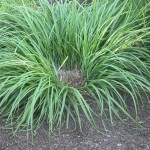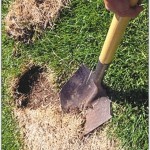Horticultural Hints – September
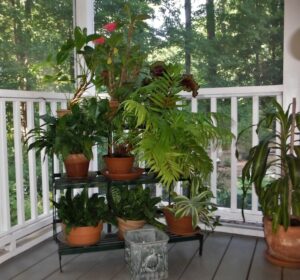 Vacation is over for your houseplants. While it is still very warm outside, houseplants that have spent the past few months under the summer sun or on a porch need to begin the transition back indoors. Those that were fully outdoors should be brought onto a porch or deck where they will receive less daylight – the first step to help them acclimate to the lower light level in your home. Plants that have been in contact with the ground should be re-potted to ensure worms, ants or pests are not tagging along. Check for any obvious signs of insects on the leaves, stems and top of the soil. Cleaning the plant using an insecticidal soap can help to keep aphids, mites and others from causing a big problem indoors. Once you make the move indoors, the drier air and lower light levels mean the plant cannot support all the foliage it did outdoors, so don’t despair if your plants drop a few leaves.
Vacation is over for your houseplants. While it is still very warm outside, houseplants that have spent the past few months under the summer sun or on a porch need to begin the transition back indoors. Those that were fully outdoors should be brought onto a porch or deck where they will receive less daylight – the first step to help them acclimate to the lower light level in your home. Plants that have been in contact with the ground should be re-potted to ensure worms, ants or pests are not tagging along. Check for any obvious signs of insects on the leaves, stems and top of the soil. Cleaning the plant using an insecticidal soap can help to keep aphids, mites and others from causing a big problem indoors. Once you make the move indoors, the drier air and lower light levels mean the plant cannot support all the foliage it did outdoors, so don’t despair if your plants drop a few leaves.
It’s a great time to take cuttings from some tender favorites such as begonia, coleus and geranium. Cut a 4-inch tip of the plant, remove the largest leaves, dip in rooting hormone and place in wet sand or a perlite/peat moss mixture. Keep this growing medium wet until a gentle tug proves that roots are in place. Then, transplant to a small pot and you have a new houseplant. In a southern window you may even get blooms.
Clean-up time. Time to start cleaning your gardens. As annuals and most vegetables reach the end of their productive life, cut them down and add the healthy material to the compost bin. Any diseased (for example, downy mildew) or insect-infested material should be bagged and placed in the trash. All garden weeds should be pulled now and bagged (and definitely not composted), chopped or otherwise made incapable of growing. Left in place, the weeds will produce thousands of seeds in your lawn and garden, making your job much more difficult next year.
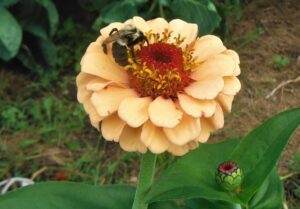 Insects. It would seem with the end of the growing season approaching, insects would be less of a problem, but that is not always the case. Like us, they’re preparing for winter. Wasps, including the yellow jackets that are often misidentified as bees, are particularly aggressive this time of the year. Remember, there are hives in the ground as well as in trees and shrubs.
Insects. It would seem with the end of the growing season approaching, insects would be less of a problem, but that is not always the case. Like us, they’re preparing for winter. Wasps, including the yellow jackets that are often misidentified as bees, are particularly aggressive this time of the year. Remember, there are hives in the ground as well as in trees and shrubs.
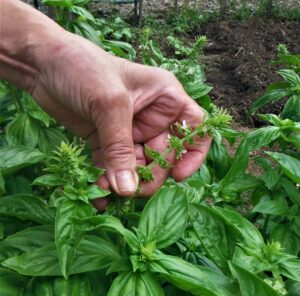
Those flowers on your basil need to be snipped off; otherwise, the plant will produce seeds rather than new leaves
In the vegetable garden. Your basil (and most other herbs) are likely sending up flower stalks. Pinch off the stalk at their base. Once your basil flowers, and those flowers are pollinated, the plant thinks its work is done and puts all its energy into producing seed rather than the leaves you want for your kitchen.
And beware of ticks, they continue to be active even as the temperatures drop. The list of dangerous tick-borne diseases grows each year. Moreover, ticks do not die with the first frost: they will survive the winter and hop onto the unwary any day the temperature is above freezing.
Raking – Don’t! Research by Cornell Extension Service shows that raking your lawn is totally unnecessary. Just use a mulching mower (almost any gas or electric-powered mower will do) to chop the leaves into small pieces which will compost directly into the soil over the winter. Cornell’s research shows up to sixteen (more than a foot) inches of dried leaves can be added to the soil every year. This includes tough oak leaves, which break down very slowly unless they have been chopped up, and pine needles, which are less acidic than oak leaves. If your leaves are deep, you may have to mow twice to chop them all sufficiently small, but it’s still a lot less work than raking and much better for the environment than throwing leaves in the trash. By mulching, all the nutrients in the leaves go back into the soil where they’ll be available for the tree roots to take them up for future years.

This Lindera needs to be shaped, but cutting it now will cause it to produce new growth that can’t harden off before winter.
Snails and slugs continue to feed on hostas and other susceptible plants. Kill them now with an iron-phosphate-based product (such as Sluggo) which, unlike older remedies, is harmless to pets, other wildlife and the environment. When cleaning your garden, remove and destroy all potentially infected plant debris because slugs leave behind eggs that will hatch next spring. If a plant had a particularly bad infestation, assume there are slug eggs in the soil or mulch and remove and bag the top layer.
Put away your pruners for now. While it is tempting, this is not the time to be pruning any woody plants around your garden. Spring blooming trees and shrubs have set their flowers for next spring, so pruning would remove those buds. As to those still blooming (or recently finished), pruning them now will encourage new growth that will likely be too tender to make it through the winter. Pruners and saws should not be used on woody plants until the cold weather is thoroughly established in November.
Look for water that can be reused. Do you have a rain barrel? Capturing the water that runs off your roof is a smart solution to water bans. A quarter to a half inch of rain will fill the barrels connected to gutters on a home roof. With a watering ban in many towns this year, after cooking eggs or vegetables, the water shouldn’t go down the drain. Some nutrients from these cooked foods will leach into the water and, once cooled, can be used to water (and feed) plants.
Leave the leaves where they fall. Mow them into the lawn to add nutrients. And stop bagging grass clippings! They will completely disappear in a couple of days unless you missed several weeks’ mowings. Not only do you save work, you are returning necessary nutrients to the soil.
It’s a great time to start composting at home. Buy (or build) a closed compost bin that give you a discreet place to recycle. Start with a layer of leaf mold (old leaves that are breaking down without any help from you) or compost from a friend. The bacteria and fungi that do the composting will be in there. Grass clippings (with or without leaves) can be added to your vegetable and fruit peelings, leftovers, or plants too far past their prime. Repeat throughout the fall and spring. Next year, you’ll have the compost needed to give a boost to your new plantings and old beds!
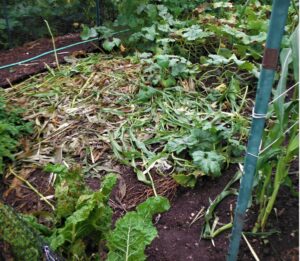
Instead of treating spent cornstalks as trash, cut them into one-inch lengths and spread them and their leaves over your garden. They’ll compost over the winter.
Add to your soil’s fertility. Create a nutrient-rich base layer by collecting grass clippings and raked leaves to spread over the bed, as long as you didn’t use “weed and feed’ or other broad-leaf weed killers (flowers and vegetables are broad leafed). With vegetable gardens, usually we take away the plants that were growing there this year to reduce the possibility of diseases or insects from wintering over. But any vegetable plant not affected by disease or insects can be chopped, and left behind. The leaves from corn plants, the overgrown lettuce heads, the tops of carrots and so forth are a starting point. But don’t forget all those leaves that fell on yours or your neighbors’ lawns. Pick them up with your mower bag and they’ll be shredded and ready to improve your vegetable garden.
Don’t forget cover crops. Cover crops become “green manures” when a gardener turns them into the soil in the spring to provide organic matter and nutrients. Green manures include legumes such as vetch, clover, beans and peas; grasses such as annual ryegrass, oats, rapeseed, winter wheat and winter rye; and buckwheat. For your home garden chose those that will grow in the fall and not need to be tilled under in the spring. You want to let Mother Nature do most of the work. Be wary of animal manure, though. Remember that not all weed seeds get digested, some manure can be too rich in one element, and that manure can carry dangerous pathogens. And it’s not fun to spread on the garden.
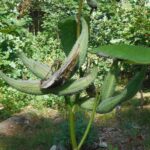 Do you appreciate Monarchs? Fall is time to collect milkweed seeds for next spring. Use only seed native to your area and pick only dry brown pods. Pods must be dry to ensure seeds are mature. Plant the milkweed in the fall in a sunny location by sprinkling seeds over loosened soil. Pat them down, add a thin layer of top dressing and water well. In the spring the plants should appear. Monarch caterpillars will be along to munch on the leaves several times through the summer. A variety of flowers throughout the summer will keep the monarch butterflies nearby.
Do you appreciate Monarchs? Fall is time to collect milkweed seeds for next spring. Use only seed native to your area and pick only dry brown pods. Pods must be dry to ensure seeds are mature. Plant the milkweed in the fall in a sunny location by sprinkling seeds over loosened soil. Pat them down, add a thin layer of top dressing and water well. In the spring the plants should appear. Monarch caterpillars will be along to munch on the leaves several times through the summer. A variety of flowers throughout the summer will keep the monarch butterflies nearby.
Renew a shrub. Do you have a foundation shrub that is too tall, too wide, or shaggy? You can give it a makeover by pruning this fall. Removing a few of the branches will encourage the growth of new stems from the roots. Late this month, prune up to one-third of the oldest, thickest stems, down to ground level or just slightly above. In the spring, young healthy branches will quickly fill in the spaces you created. If it’s a blooming shrub, you may have to wait another year in order to get flowers on those branches. But rejuvenating the shrub is the best way to keep it blooming and attractive as the years go by.
Weed every chance you get. Every weed you remove in the Fall – so it doesn’t spread seeds – is a thousand weeds you won’t have to remove in the spring!
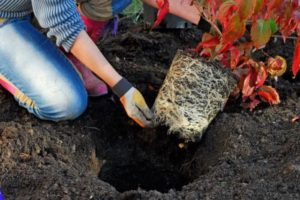
Autumn is a great time to plant, but stock may be root-bound from being in a pot all summer. Tease apart roots and remove excess ones.
Plant woody plants ASAP. If you find yourself with a new tree or shrub, get it in the ground as soon as possible. It will need to grow roots to withstand winter winds and to supply water to the plant until the ground freezes. Dig a hole wider than the root ball of the plant (to help the new roots), tease out any winding roots, and create a saucer around the stem to direct water into the root zone. Water until the ground freezes if the autumn rain is not generous. Evergreens, because they keep their foliage, are especially vulnerable in their first winter. Add six inches of mulch (for the first winter only, and keeping the mulch away from the plant’s stem) before the temperature drops, to keep the roots warmer a little longer so they can continue to grow and take up water.
Get a soil test this fall. If you wait until spring to send in soil for a soil test, you may find yourself with a lengthy wait, as labs are inundated with requests as soon as the soil is workable. A test done in the fall gives you a chance to start improving your soil over the winter when you have time to affect beneficial changes.
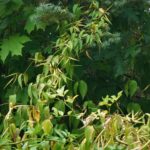
Early September is your last opportunity to stop swallowwort. Bag the vine – and especially its seed heads – and send to your town’s transfer station to be incinerated.
Your last opportunity to do something about swallowwort. By early September, seed heads on black swallowwort – which is deadly to certain caterpillars – are turning brown. Once they ripen, seed pods will open and – like the milkweed to which it is related – the seeds will scatter on the wind. If you see swallowwort with seed heads, pull it, bag it, and put it out with the trash – never compost it. The butterflies you see next spring will be your thanks.
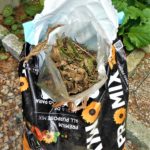
Never compost a diseased plant. Instead, bag them up, remove them from the garden, and send them to be incinerated
Begin the vegetable garden clean-up by removing plants that have passed. Any diseased plant should be bagged and put in the trash. Only healthy, disease-and insect-free plants should be composted. Also remove any fallen fruit (vegetables can host disease or insects over the winter as well as the plant.) If you are not planning a fall/winter garden, plant a cover crop of annual rye grass or use leftover peas and bean seeds. These will die during the winter but continue to prevent soil erosion over the winter and add nutrients next spring.
Keep planting your winter vegetables as you open up space in the garden. Spinach, arugula, beets, swiss chard, radishes, many oriental greens and even peas can tolerate enough cold to produce a crop between now and the first serious frost. Add a layer of row cover (available at nurseries and online) and you can serve fresh garden vegetables for Thanksgiving, and possibly beyond.
Preparing for the nibblers and gnawers. Deer, rabbits, and rodents damage your plants by feeding on foliage, twigs, and bark when their regular diet disappears in the winter months. Wrapping tree trunks is a way to keep your landscape safe from hungry critters. Place plastic tree guards around the bottom of your deciduous trees (especially young or newly planted ones) to keep rabbits and mice from gnawing. Chicken wire barriers or cages around your trees, shrubs, and plants are often the best solution to keep rabbits at bay. Applying repellent sprays to the trunks, branches, and stems of evergreen trees and shrubs is a great option. Repellent sprays will need to be re-applied monthly but teach critters to look elsewhere year round.
Dig up your gladioli, caladiums, cannas and tuberous begonias before the first frost. Dry them in a garage or airy garden shed, remove the excess dirt and browned shoots. Place them in mesh bags or in open boxes with identifying tags, and lightly cover then with Styrofoam ‘peanuts’ in a dry, cool (not freezing) location for the winter.
And then there’s the snail and slug explosion. They, too, appreciated the wet weather. They’re hungry and ready to lay eggs for next year. Fortunately, there is a safe, effective solution. Purchase only products that contain the chemical iron phosphate. It doesn’t hurt the environment, animals, your plants or anything except slugs and snails. Luckily the bad guys find it appealing and fatal. Reducing their numbers in the fall means fewer will hatch next spring to eat your hosta, your tomatoes and just about anything else they find.
Lawn care starts with a soil test. If you didn’t do one in the spring, do it now. The $25 test from UMass tells you what your soil needs to grow what you want to grow. They give you specific recommendations for improving lawns, gardens, whatever you ask about. Do it now and you’ll have plenty of time after you get the results back to add lime, or fertilizer or whatever is recommended by the experts in October or November.
Support migrating pollinators and other birds as they travel through your backyard on their way to a winter home. Here are a few tips on how to help them on their way:
Hummingbirds may travel up to 2,000 miles to Central America. A hummingbird feeder in your garden is a welcome refueling stop for them.
Monarch butterflies are heading south toward Mexico and southern California, flying up to 3,000 miles. If you don’t have them already, plant native milkweed and late blooming nectar plants such as goldenrod and asters to feed them.
Migratory songbirds need you to plant trees and shrubs to provide them with a place to roost and to refuel on berries or insects during their travels.
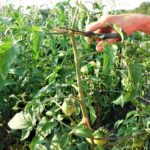
‘Top’ your tomatoes at the beginning of September and they will put their energy into ripening green tomatoes rather than forming new ones.
In the vegetable garden. Tomatoes have taken over center stage now, and perhaps your kitchen counter. But they cannot tolerate cool temperatures so remove the topmost growth on plants to encourage ripening what is already on the vine, instead of producing more fruit that will not have time to ripen.
For better results storing them, allow winter squash and pumpkins to thoroughly ripen before harvesting. And remember, once harvested, to keep them in a cool but not cold place.
As each vegetable finishes producing, remove the plants from the garden in order to prevent diseases or pests from wintering over in the old foliage. Sowing winter (or ‘annual’) rye will provide roots to stop erosion of uncovered soil, and when turned over in the spring, it will add nutrients and biomass to the garden.
Winter squash and pumpkins are ripening on the vine now. Do not pick pumpkins until they have turned uniformly orange. When picking winter squash always cut the squash from the vine leaving at least two inches of stem attached. This makes the squash less likely to rot in storage. Wash the picked, undamaged squash in a ten percent bleach solution and then allow them to dry in the sun for a couple of days. They will keep in a cool dry room for months providing a dish from your garden long after it is buried in snow.
It’s time to tell some plants to stop producing and concentrate on ripening. Around Labor Day, I cut the growing tips off tomatoes and winter squash. There is very little chance they will manage to put out new flowers, grow the pollinated flowers into squash or tomatoes that will ripen before that first real frost. I want my plants to concentrate on putting all their energies into growing and ripening the tiny green tomatoes into large red slicing tomatoes and the similarly small and greenish winter squash into large, brown winter squash for my Thanksgiving and Christmas table.
In the Flower Garden. Autumn is a great time to divide and plant many perennials. If your perennials have finished blooming, consider digging and dividing them. Everything from peonies to bleeding hearts can benefit by creating divisions of the ‘mother’ plant. As you plant, make certain to put divisions into ground at the proper depth—exactly as deep as they were growing before. And enrich the soil with compost or well-aged manure to give the roots a great start. Don’t allow the new plantings to dry out, and don’t mulch the area until cooler temperatures arrive.
And you can plant seeds now! Some flowers (such as bachelor buttons) do better if they are planted in the fall (the way Mother Nature would) and allowed to winter over. In the spring you will have a serious jump on those only putting their seeds in the ground meaning stronger, earlier flowers next summer.
September is the month to plant all narcissus (daffodils) as well as smaller bulbs. Don’t plant tulips until the end of the month. And remember, while deer and rabbits love tulips, they generally ignore daffodils and hyacinths.
Invasives Alert. A really bad guy, Japanese Knotweed was brought to this country as a decorative plant, but it also a terrible thug. It spreads by seed but also by underground rhizomes. Because of its ability to root from cut canes (!), always bag all parts of knotweed and send it to your local transfer station. After you’ve cleared an area, make a note to go back in a month to six weeks, where you’ll find the knotweed thriving again. Keep repeating the cut-and-bag process because it takes at least four cuttings to kill the underground rhizomes. Why bother? Because knotweed is bad for the environment. It crowds out native plants that native birds and animals depend on.
Row covers are back in fashion. The row covers you used in May and June to keep out bean beetles and other bad bugs can be pulled out again, this time to provide a few degrees of nighttime protection against cold. Check your town’s swap area for a hard plastic or glass covers (old doors or windows work well) to give you a simple cold frame that can keep your garden growing until covered with snow. You can add 60 days or more to your growing season.
Freshen your containers. It has been a tough summer for plants in containers. The unrelenting heat and the regular dousing with chlorinated tap water (in place of the non-existent rain) is not conducive to a long happy life for your annuals. It’s too early to use cut evergreens, so consider putting in some transitional plantings such as the multi-colored kale, perennial grasses and heuchera. Avoid using mums. They aren’t a good choice if you like to keep the season going until Thanksgiving because the flowers will die long before that.
Benign neglect for your lawn. The summer heat and water bans have been tough on everyone’s lawns, but don’t try to rehab them this autumn unless Mother Nature suddenly provides us with lots of rain and the watering bans are ended. Apart from pulling crabgrass and other obvious weeds before they set seed, leave your lawn be. Grass is a hardy, cool-weather perennial, and there are steps you can take later this autumn and next spring to enhance your lawn.
Spring bulbs. Wait until the soil temperature has dropped to 55 to 60 degrees several inches below the surface to plant spring bulbs. This usually occurs after several weeks of nighttime temperatures in the low 50’s. Putting bulbs into warmer soil may cause them to begin growing tops (which is bad) when they should be growing only roots to support the flowers next spring. Now is also a good time to dig up any bulbs that have been in for a few years. You’ll likely find they’ve multiplied and are now crowded (yeah! free bulbs) and need to be thinned; or have been attacked by moles, voles and other varmints and need to be replaced. Add lime over old and new bulbs now, but fertilize only after they are in bloom in the spring.
Take Pictures, Make Plans. If your garden is perfect, take its picture. If your garden is looking tired, take its picture. If your garden doesn’t make you happy, take its picture. If you do this once a month through the spring, summer and fall, you have the information to help figure out why your garden is perfect, tired or not making you happy. By analyzing those photos you can see where you need to add more spring bulbs, late summer plants or shrubs and trees to provide structure to your garden throughout the year. Didn’t take any photos in the spring? Start now. And don’t forget to take some in the winter! Only by looking at your successes and failures can you make plans for the garden that doesn’t disappoint. Whether you do your own landscaping, or have someone do it for you, it’ll be more successful when you can point out what you like or dislike about the garden you have now.
Your garden journal. How did your garden fare? What needed the most watering? What vegetables did best, and worst in this weather? What would you give another chance because it was a cool summer? What’s off your grow list for next year?
If you kept up your garden journal – making even one or two entries a week – you could easily answer those questions. If not, take an hour today and write down what you remember, and what you’d rather forget. It will help you next year and in future years to make your garden better – and perhaps your work a little easier.
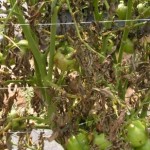
If your tomatoes have been stricken by late blight, be sure to remove every trace of the affected plants.
Late blight makes its its ugly presence known in gardens in September. Tomato and potato plants infected with blight need to be bagged and sent to the trash. This includes fruit that fell from the vine before ripening as well as dead leaves. As a general rule, it is much better to be safe by sending any plant material from your garden that was insect- or disease-infected to the dump rather than the compost heap.
Insects. It would seem with the end of the growing season approaching, insects would be less of a problem, but that is not always the case. Wasps, including the yellow jackets that are often misidentified as bees, are particularly aggressive. Beware of hives in trees, shrubs and in the ground.
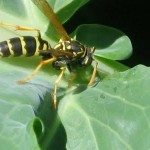
Insects become aggressive as the season winds down. Yellowjackets are especially a problem, and always be wary of ticks.
Snails and slugs continue to mar hostas and other susceptible plants (I found a snail this weekend on a branch of a leopard lily ( Iris domestica) five feet above the ground). Kill them now with an iron phosphate based product (such as Sluggo) which, unlike older remedies, is harmless to pets, other wildlife and the environment. When cleaning your garden, remove and destroy all potentially infected plant debris because slugs leave behind eggs to hatch next spring.
Be on the lookout for Asian long-horned beetles or signs of their activity. Perfectly round, dime sized holes in the trunk of maples, birches and other hardwood trees indicated their presence. Report any suspected infestations to www.massnrc.org/pests/albreport.
And beware of ticks, they continue to be active even as the temperatures drop. The list of tick-borne diseases grows each year. Moreover, ticks do not die with the first frost: they survive to hop onto the unwary any day the temperature is above freezing.
It’s also a great time to dig up and divide perennials that are getting tired (a dead spot in the middle of irises, a lack of bloom on older plants). Allow fall-blooming perennials to continue to shine, but just about all others will thrive if replanted in fresh soil amended with compost, are watered until the ground freezes (probably early December) and mulched with two or three inches of fresh mulch to keep the ground from thawing out with each warm day in the winter. Hardy plants aren’t killed by freezing weather; they succumb when warm days thaw the soil, heaving their roots out of the ground.
Lawn reseeding and general maintenance. Those of you who read this column regularly know I am not a fan of large lawns. But if you are going to have one, now is the time to put in the work to make it better next summer. Most weeds that homeowners want out of their lawns are annuals. Any that might pop up while you rehab your lawn now won’t be here to bother you in the spring. Reseeding, also known as overseeding adds new grass plants to your existing lawn. The more grass, the less room for weeds. If you are like me and don’t enjoy extra work or chemicals, consider adding clover seed, a traditional part of the home lawn. Clover takes nitrogen (the largest part of any lawn fertilizer) from the air and puts it in the ground in a form available to its neighbors, such as your grass. Clover seed is available at farm stores and some nurseries.
Invest in good seed – cheap seed may contain annual grass seed which will die over the winter (not the perennial seed you want), or even weed seeds! Make certain you buy seed appropriate for the area: sunny, shady, play area etc. Remember that no grass will grow well in areas where you get less than four hours of sun a day. You’re much better off using your money to buy a shade-tolerant ground cover.
If you haven’t aerated your lawn in several years, it may need it. Do the aeration, then seed.
Once you have seeded, you must water daily for a couple of weeks. Grass seed most be kept moist enough to germinate.
Do you have bare spots or a thin lawn? Now is the time to deal with these problems. If the dog likes one area too much or if the kids preferred one spot for home plate, dig out the soil under the dead grass to create a hole 6 to 12 inches deep. Replace the depleted dirt with fresh soil amended with compost. Tamp it down, add high quality seed and water once or twice daily for two weeks or until you see grass blades several inches tall.
Cleaning up Flower Beds. Whether you prefer a fall or spring clean-up, it’s important to remove any diseased plant material now. Our wet spring and hot July seemed a perfect recipe for mildew in my own garden. Remember to sharpen your cutting tools before beginning. Dull blades tear plant material and allow insects and disease easy entry. When cutting down a plant with mildew, or any fungal disease, practice good sanitation. Keep a container of bleach with you and dip your shears or pruners in the bleach before each cut. It may sound like extra work, but preventing the spread of disease will save you much more time and effort than it takes to make the quick dip. Get in the habit and you won’t accidentally use the ‘dirty’ pruner to cut an uninfected plant. Disease can travel down stems and winter over in the roots, ready to attack in the spring. Put the diseased plant material in separate containers from the clean, compostable material. Then take the diseased material to your dump or transfer station where it won’t become part of next year’s garden. Only clean – disease-free and pest-free – plant material belongs in your compost bin.
Lawn reseeding and general maintenance. Those of you who read this column regularly know I am not a fan of large lawns. But if you are going to have one, now is the time to put in the work to make it better next summer. Most weeds that homeowners want out of their lawns are annuals. Any that might pop up while you rehab your lawn now won’t be here to bother you in the spring. Reseeding, also known as overseeding adds new grass plants to your existing lawn. The more grass, the less room for weeds. If you are like me and don’t enjoy extra work or chemicals, consider adding clover seed, a traditional part of the home lawn. Clover takes nitrogen (the largest part of any lawn fertilizer) from the air and puts it in the ground in a form available to its neighbors, such as your grass. Clover seed is available at farm stores and some nurseries.
Invest in good seed – cheap seed may contain annual grass seed which will die over the winter (not the perennial seed you want), or even weed seeds! Make certain you buy seed appropriate for the area: sunny, shady, play area etc. Remember that no grass will grow well in areas where you get less than four hours of sun a day. You’re much better off using your money to buy a shade-tolerant ground cover.
If you haven’t aerated your lawn in several years, it may need it. Do the aeration, then seed.
Once you have seeded, you must water daily for a couple of weeks. With the ground saturated right now (thank you, Irene), you should not have difficulty keeping the seed moist enough to germinate.
If you have access to compost, spread the seed and add a thin (1/4 inch) layer of compost over the top. It will disappear quickly while providing a healthy start for your seed.
Planting for fall/winter It’s been a long hot summer and the last thing some of us are thinking is planting at this time of year. But it might be a good idea to reconsider. We can see where our garden needs a boost. It is easy to plan a spring and summer garden; harder to think ahead to where we need color or structure for the fall and winter months. Nurseries are full of plants that can offer exactly that, and they’re likely on sale.
I am not a fan of chrysanthemums for fall. The colors are too brassy, the plants too short lived. I leave annuals in place until they are killed by frosts (usually the same time that the mums would be killed) and supplement them with perennials that will provide color throughout the winter. Heuchera are wonderful plants that show off their colorful leaves year round (when not buried under snow). Those not watered may have suffered this summer, but cutting back dead leaves will lead to fresh replacements. In shady areas, plant epimediums, which keep their greenery throughout the winter and add flowers to the shade in the spring.
Daylilies are true workhorses but, like many other perennials, they cannot go on forever without some care. Daylilies need to be dug up and divided every three to four years to keep the plants youthful, and September is a great time for this chore. For the sake of convenience and because they’ll have fewer roots when you are finished, first cut the foliage in half. Shake or wash most of the dirt off the roots. Daylily roots are tough and you’ll need a pair of spading forks or a sharp shovel to break apart the mass. Discard the old center and replant divisions that are 6 to 8 inches across. Too many plants? Share them with friends, just remember to make note of the blossom color when potting them up.
